INTRODUCTION
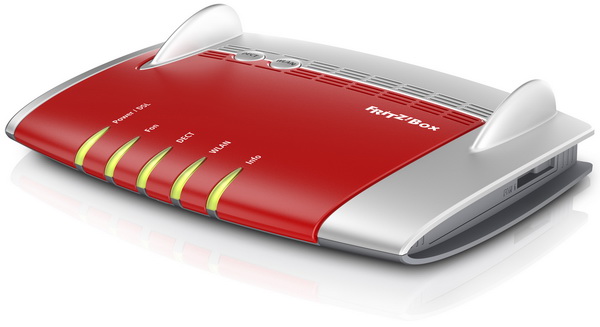
Up until roughly a year ago where i live ISP's (internet service providers) provided 100Mbps modem/router models to their ADSL/VDSL subscribers (some still only give 1GbE models to VDSL subscribers) and if you've been following our past reviews (or if you've looked into the web interface of one such model) then you should already be aware that these usually lack many useful features and settings (cut-down or slim versions as we like to call them). Unfortunately since the majority of network hardware manufacturers focus primarily in the development and release of standalone routers there aren't nearly as many choices when it comes to modem/routers and that has always been a problem for consumers. AVM is probably one of a handful manufacturers that still focus in releasing high performance modem/routers and today with us we have their FRITZ!Box 7560 AC1300 VDSL/ADSL Modem Router.
AVM offers a wide range of products for high-speed broadband connectivity and smart home networking. With its FRITZ! product line, AVM is a leading manufacturer of broadband devices for DSL, cable, LTE (4G) and fiber optics in Germany and Europe. Smart Home products based on wireless LAN, DECT and powerline standards provide for an intelligent as well as secure home. The operating system FRITZ!OS makes handling all FRITZ! products easy. Thanks to free updates all FRITZ! products regularly receive new functions for more convenience and increased security. FRITZ! is the leading brand for home networking in Germany. Founded in Berlin in 1986, from the outset the company has focused on developing its own secure, innovative products for broadband connections. In 2016 the communications specialist had 660 employees and generated a turnover of 440 million euros.
Just like many other manufacturers AVM uses numbers to categorize their products so although the FRITZ!Box 7560 may not be on equal footing with the 3490 (last two numbers reveal the performance category of each model) which we reviewed last it does comes with DECT base station (supports up to 6 handsets) and IP telephony features (including a useful answering machine) like the 7490 which we had with us a couple of years ago. It's also fully compatible with VDSL2/ADSL2 lines since it comes ready with a built-in modem (up to 100Mbit for VDSL lines with support for full vectoring) and also features dual-band AC1300 (AC1316 to be exact) Wi-Fi connectivity (5GHz 802.11ac at 866Mbps and 2.4GHz 802.11n at 450Mbps), 4 Gigabit RJ45 LAN ports, analog telephone port and a single USB 2.0 port. For the FRITZ!Box 7560 AVM has paired the Intel AnyWan GRX350 CPE Network Processor (dual-core with integrated Gigabit Ethernet Switch, PHYs, VoIP engine and codecs) with their XWAY VRX318 DSL transceiver, 3x3 802.11ac Wave-2 radio solution by Qualcomm (Peregrine QCA9882), 3-stream 802.11n radio solution by Qualcomm (Osprey AR9381), 1GB NAND flash by MXIC, 5 antennas and a total of 256MB DDR3L-1600 DRAM (by Nanya in our sample). Just like with all of the modem/routers we've received by AVM the FRITZ!Box 7560 uses their FRITZ!OS which today is up to version 06.83 (also the one used for this review).
SPECIFICATIONS AND FEATURES

PACKAGING AND CONTENTS
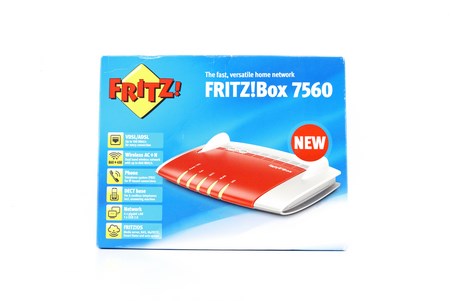 AVM packs the FRITZ!Box 7560 inside a blue box that has a large product picture at the front along with the main product features and the FRITZ logo.
AVM packs the FRITZ!Box 7560 inside a blue box that has a large product picture at the front along with the main product features and the FRITZ logo.
A more extensive features list is also showcased on the left side of the box.
 Several pictures placed at the rear are used to showcase the product features which are printed in 6 languages.
Several pictures placed at the rear are used to showcase the product features which are printed in 6 languages.
 A large piece of cardboard takes the entire interior and is used to keep the device and its bundle safe.
A large piece of cardboard takes the entire interior and is used to keep the device and its bundle safe.
 Along with the FRITZ!Box 7560 modem/router and its power adapter you will also get an 1.5 meter long RJ45 Ethernet cable, 4 meter long phone cable, warranty information paper, product brochure and the quick start guide.
Along with the FRITZ!Box 7560 modem/router and its power adapter you will also get an 1.5 meter long RJ45 Ethernet cable, 4 meter long phone cable, warranty information paper, product brochure and the quick start guide.
THE FRITZ!BOX 7560 EXTERIOR
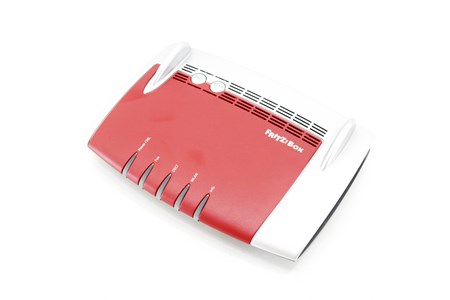 At first glance the FRITZ!Box 7560 is identical to the 3490 and 7490 models.
At first glance the FRITZ!Box 7560 is identical to the 3490 and 7490 models.


There are two round buttons (DECT and WPS) and 5 large activity LEDs (power/internet, phone, DECT, WLAN on/off and info) at the top of the enclosure.

 One USB 2.0 port is placed on the left side while on the right side we see an analog phone port.
One USB 2.0 port is placed on the left side while on the right side we see an analog phone port.
 Moving at the rear we find the DSL port, phone port, 4 Gigabit RJ45 Ethernet ports, and the DC in.
Moving at the rear we find the DSL port, phone port, 4 Gigabit RJ45 Ethernet ports, and the DC in.
 At the base of the FRITZ!Box 7560 we find four rubber feet, two vertical wall mounts and a large sticker which contains the serial number, barcode and the WiFi and interface passwords.
At the base of the FRITZ!Box 7560 we find four rubber feet, two vertical wall mounts and a large sticker which contains the serial number, barcode and the WiFi and interface passwords.
THE FRITZ!BOX 7560 INTERIOR
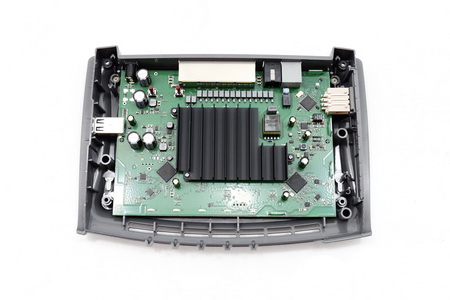
Here we see the Atheros Osprey AR9381 802.11n radio solution, Qualcomm Peregrine QCA9882 802.11ac radio solution and the Dialog DECT processor.
Underneath the black heatsink AVM has placed the 256MB DDR3L-1600 DRAM by Nanya, 1GB NAND flash by MXIC and the AnyWan GRX350 Dual-Core Network Processor.
SETUP
After you’re done with the hardware installation you need to just launch your Internet browser to select your language and start the setup procedure (if you’re not redirected automatically then go to http://fritz.box or 192.168.178.1).

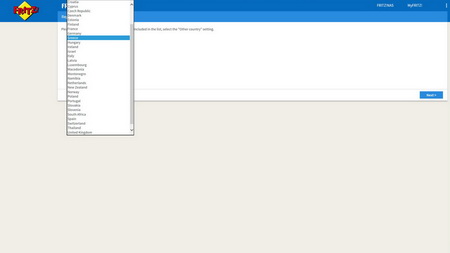

The setup procedure asks you to enter your password (available at the base sticker) and choose between Annex A or B line type (A for PSTN and B for ISDN) and choose your region (after that it will do a quick restart).




Finally the wizard will ask you to choose the type of connection (DSL or Cable) after which it will take a couple of minutes to check your settings and verify the internet connection.
FRITZ!OS 6.83 PART 1
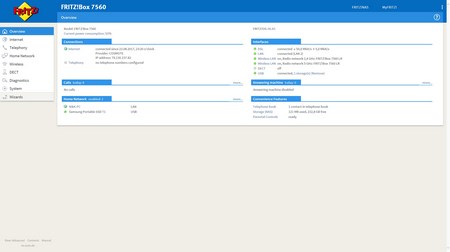
Once you login the web GUI you will be redirected to the overview screen from where you can test the current power consumption, check the current connections (including internet status) and used interfaces and see which devices are currently connected to the device.
By default the FRITZ! OS (web GUI) is set on standard view (lower end of the screen) and so if you really want access to everything the FRITZ! Box has to offer i strongly suggest using advanced mode.














Through the Internet drop down menu you can check the utilization of your internet connection (there are a couple of nice graphs here) and the amount of data send and received, setup your connection (IPv6 is supported), set individual parental filters and connection prioritization for all connected devices, setup VPN, enable/disable access to the FRITZ!Box from anywhere in the world (either via DyDNS or MyFRITZ! Account) and finally you can monitor your DSL connection from the most detailed information pages one can find in a modem/router today.
The Telephony drop-down menu can be used if you connect a phone with the device and allows you to check the calls list, configure the answering machine, access stored telephone numbers, setup the phone (or phones) as alarms, setup the fax function and also allows you to handle/redirect all incoming calls.
FRITZ!OS 6.83 PART 2
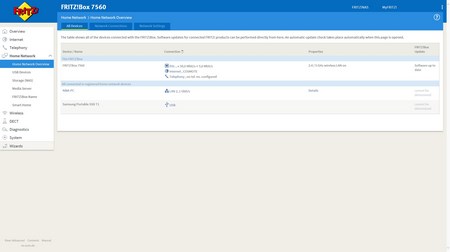






Next on the list is the Home Network drop-down menu and from here you can once again see which devices are connected to the FRITZ!Box (both wired and wirelessly – you can also make the FRITZ!Box read the status of other smart devices in your local LAN), adjust some network settings including the guest access (perhaps the most important is to enable all 4 Gigabit ports since by default only the first is), enable/disable the onboard storage of the FRITZ!NAS function (you can also configure an external HDD/flash drive if connected to the USB 2.0 port) and setup the media server feature.





The WLAN drop-down menu is self-explanatory really so here you can setup the two bands (2.4/5GHz), check and see which devices are connected and how to the FRITZ!Box (wirelessly), monitor the wireless environment to see if something is interfering with the signal, configure the encryption type, schedule when you want WiFi to be on and when not, create a guest WiFi access mode and change the operating mode of the unit (access point or repeater).
As usual we didn't use the DECT feature of the device but as you can see from the drop-down menu there are plenty of available options to play with.


Via the diagnostics page you can run quick diagnostics on both the unit and its security settings.






Checking the event logs, unit power consumption, adjusting the use of the two buttons at the top (or locking them entirely) and the activity LEDs, performing OS updates, backing up all your settings and setting the region, language and time is easy through the system drop-down menu.
TESTING METHODOLOGY
To sufficiently test modem/routers we had to change our methodology quite a bit since we decided to make use of the online internet speed measurement application called SpeedTest (we use it with two different destinations/servers). SpeedTest may not be the most "accurate" way to test internet connection speeds since variables change all the time from our ISP to the ISPs of the servers SpeedTest makes use of but the same can be said for every single way one can test internet speed. Bottom line whatever the results always remember that they may not be 100% on the spot. To somehow "help" our results we also record the connected downstream/upstream values each modem/router is able to get into our charts (reboot the modem/router 6 times to get the average upstream/downstream value).
The rest of our testing methodology involves testing the wireless capabilities of the modem/router at hand and thus it's the exact same we use when testing standalone routers. So once again we will be using the networking benchmark by Passmark (v.8), the QCheck by Ixia and ATTO 2.47 (since April 2015). Since we need to test new features and specifications all routers are benchmarked with their highest available wireless standard/band (5GHz in this case). Our systems are outfitted with Kingston HyperX Predator 480GB PCIe SSDs, AC1200 USB 3.0 adapters (we received AC1900 models but so far our results have been somewhat inconclusive in order to replace our AC1200 with them) and CAT7 cables and are placed 15m away from the router with 3 concrete walls between them. Each test is repeated a total of 6 times after which the average scores are recorded into our charts. Both systems have Windows 7 Ultimate SP1 installed with all the updates until the 23rd of August 2017.
We’ve received several requests by some of you to also measure power consumption when testing modem/routers and although differences are not that great between similar models we decided to do so (average power consumption during tests is placed in our charts). Also again after many requests from April 2017 we will also do our best to measure wired USB performance of any modem/router or standalone router that gets to our lab with the help of Crystal Disk Mark v5.1.2 and a Samsung T1 250GB Portable SSD.
TEST RESULTS
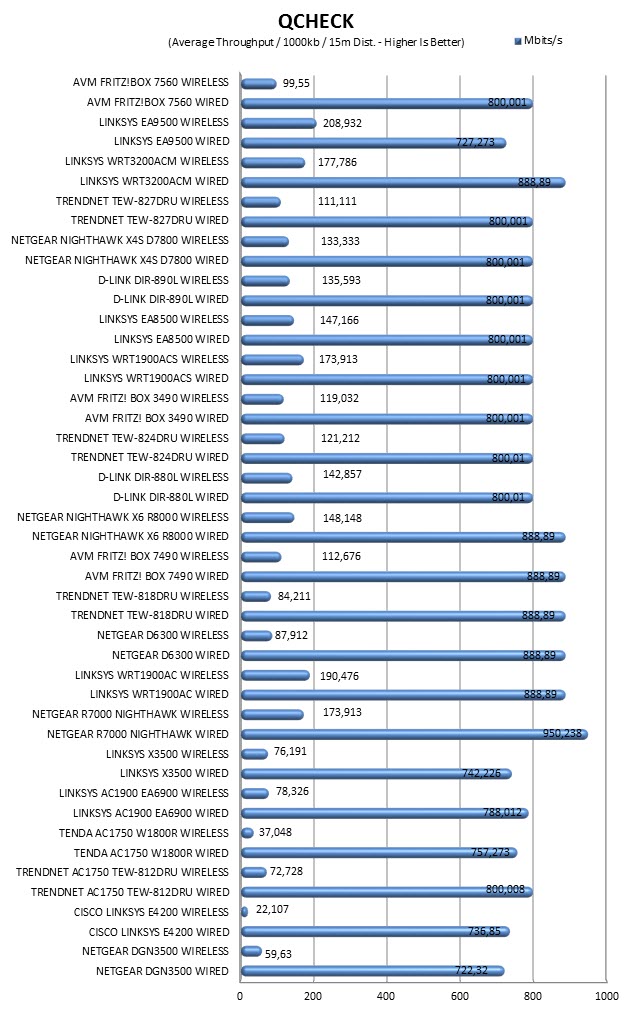






CONCLUSION
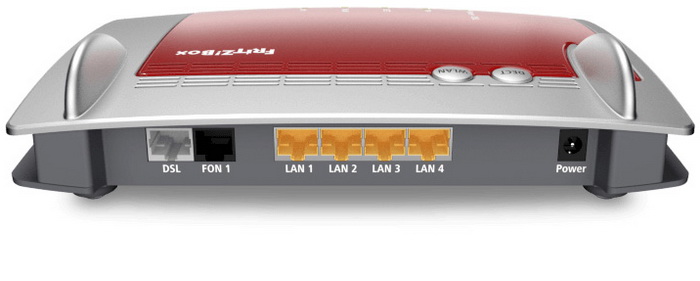
After spending over a month with the FRITZ!Box 7560 AC1300 VDSL/ADSL modem router we can say with certainty that it’s yet another solid model by AVM which will obvious be a serious upgrade to whatever it is your ISP provided you with. Wired performance thanks to the 4 Gigabit RJ45 ports is excellent as expected and during our tests the FRITZ!Box 7560 had nothing to be jealous in terms of internet download and upload speeds when compared to the D7800 which we’ve been using at the office since our review of it. Wireless AC performance may not be stellar and on par with what we’ve seen lately by other AC models (including some by AVM) but that’s not what the 7560 model was released for (go for one of the xx90 models if wireless performance is what you’re after) so we can’t really complain. Unfortunately for unknown reasons AVM decided to use a single USB 2.0 port this time over which really makes very little sense when most of their competition uses USB 3.0 ports. We do realize that not many people care about USB performance but still we were hoping for more from one of AVM’s latest models. As for the FRITZ!OS well we still believe it’s one of the best and most detailed web interfaces currently in the market although our two pages showcasing it really speak for themselves.
Currently the FRITZ!Box 7560 AC1300 VDSL/ADSL Modem Router retails for 151.90Euros inside the EU (Amazon.de) a price tag which puts it roughly 20% beneath what you need to get the highest-performance 7490 model. Personally I think that spending 20% more to get the 7490 model is not a bad deal if you care about wireless and USB performance but if those don’t matter then the 7560 will do just fine. Overall we think that AVM has once again released a solid modem router in the market that packs a very good price/performance ratio and that’s why it gets our Golden Award.

PROS
- Overall Build Quality
- AC1300 Technology (Concurrent 802.11n & 802.11ac)
- Compatible With All Line Types (Annex A/B)
- Available Features (Repeater/NAS Server/Media Server/DECT Station/IP Telephony)
- Overwhelming Number Of Settings
- Android & iOS App
- 4 Gigabit Ethernet Ports
- 5 Year Warranty
CONS
- No Dedicated WAN Port (LAN 1 can be used for that)
- USB 2.0 Port

 O-Sense
O-Sense

















.png)

